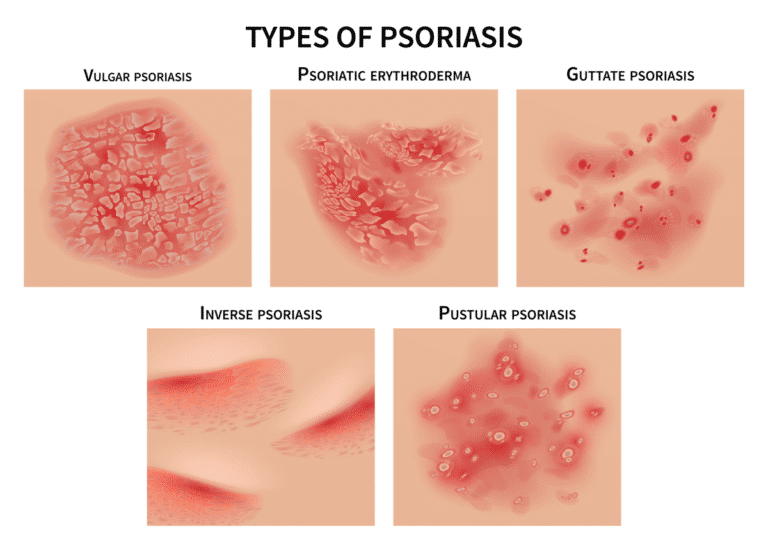Psoriasis is a chronic skin condition that affects millions of people worldwide, causing inflamed patches of skin called plaques. These plaques are often raised and covered with silvery scales, and they can be itchy, painful, or prone to cracking and bleeding. While psoriasis plaques can develop on any part of the body, certain areas are more commonly affected.
In this article, we’ll explore the eight most common locations for psoriasis plaques, how psoriasis may affect these areas, and strategies to manage symptoms effectively.
1. Elbows
Psoriasis often develops on the elbows due to the frequent friction and pressure in this area. The plaques on the elbows are usually thick and may crack, especially in dry weather or if the skin is not moisturized.
Tips for management:
- Use thick moisturizers or ointments to keep the skin hydrated.
- Avoid rubbing or scratching the area, as it can worsen irritation.
- Apply prescribed topical treatments like corticosteroids or vitamin D analogs.
2. Knees

Like the elbows, the knees are a common site for psoriasis due to friction and pressure. Plaques on the knees can sometimes make it uncomfortable to kneel or move freely.
Tips for management:
- Moisturize regularly to prevent cracking.
- Consider using a salicylic acid cream to help reduce scaling.
- Wear loose, soft clothing to minimize irritation.
3. Scalp
Scalp psoriasis can range from mild, with fine scaling, to severe, covering the entire scalp with thick, crusty plaques. It may extend to the hairline, forehead, or back of the neck, causing itching, flaking, and sometimes hair loss.
Tips for management:
- Use medicated shampoos containing coal tar, salicylic acid, or ketoconazole.
- Apply topical treatments like corticosteroid solutions or foams.
- Avoid harsh hair products and use a gentle comb to remove scales.
4. Face
Psoriasis on the face can be particularly distressing, as it’s a highly visible area. The plaques may appear on the forehead, eyebrows, or around the hairline. Facial psoriasis often requires gentler treatments to avoid irritation.
Tips for management:
- Use mild, fragrance-free cleansers and moisturizers.
- Apply low-potency topical steroids or non-steroidal options like calcineurin inhibitors (e.g., tacrolimus).
- Always use sunscreen, as UV exposure can exacerbate symptoms.
5. Trunk
The trunk, including the chest, back, and abdomen, is another common area for psoriasis plaques. This area can be affected by friction from clothing or sweat, particularly during physical activity.
Tips for management:
- Wear loose, breathable fabrics to reduce irritation.
- Use topical treatments like coal tar ointments or corticosteroids.
- Keep the skin moisturized, especially after bathing.
6. Hands and Feet
Psoriasis on the hands and feet can be particularly challenging because these areas are frequently used and exposed to external irritants. Symptoms may include cracking, pain, or difficulty performing daily activities.
Tips for management:
- Use thick emollients to prevent dryness and cracking.
- Protect the skin by wearing gloves when doing household chores or handling chemicals.
- Follow your doctor’s recommendations for topical or systemic treatments.
7. Genital Area
Psoriasis in the genital area, often referred to as inverse psoriasis, typically appears in skin folds and can cause redness, irritation, and discomfort. The sensitive nature of this area requires specialized care.
Tips for management:
- Use gentle, non-irritating cleansers and moisturizers.
- Apply low-potency corticosteroids or other topical treatments as prescribed by a doctor.
- Wear loose-fitting cotton underwear to reduce friction.
8. Soles of the Feet
Psoriasis plaques on the soles of the feet can make walking or standing painful. The skin may crack or bleed, especially if left untreated.
Tips for management:
- Soak feet in warm water to soften scales, followed by applying a thick moisturizer.
- Use medicated creams prescribed for psoriasis, such as steroid ointments or coal tar preparations.
- Consider using insoles or padding in shoes to reduce pressure on affected areas.
Table: Common Psoriasis Locations and Management Tips
| Area | Symptoms | Management Tips |
|---|---|---|
| Elbows | Thick plaques, cracking | Moisturize, use corticosteroids, avoid friction |
| Knees | Thick, itchy plaques | Apply salicylic acid creams, wear soft clothing |
| Scalp | Flaking, crusting, itching | Use medicated shampoos, avoid harsh hair products |
| Face | Redness, scaling, plaques | Use low-potency steroids, apply sunscreen |
| Trunk | Plaques on chest, back, abdomen | Wear breathable fabrics, moisturize regularly |
| Hands and Feet | Cracking, pain, difficulty in daily tasks | Use emollients, wear gloves, apply medicated creams |
| Genital Area | Redness, irritation, discomfort | Use gentle cleansers, wear cotton underwear |
| Soles of Feet | Cracking, pain, bleeding | Soak feet, apply moisturizers, use insoles |
General Tips for Managing Psoriasis
- Hydration: Keep your skin moisturized to reduce dryness and scaling.
- Avoid Triggers: Identify and avoid triggers like stress, smoking, alcohol, and harsh soaps.
- Follow Treatment Plans: Adhere to prescribed treatments and communicate with your doctor about any concerns.
- Gentle Skin Care: Use mild, fragrance-free products to avoid irritation.
- Sunlight Exposure: Moderate sunlight can help, but use sunscreen to prevent sunburn.
Authentic US Sources for More Information
National Psoriasis Foundation (NPF): www.psoriasis.org
American Academy of Dermatology (AAD): www.aad.org
Mayo Clinic: www.mayoclinic.org
National Institutes of Health (NIH): www.nih.gov
Centers for Disease Control and Prevention (CDC): www.cdc.gov
Conclusion
Psoriasis can affect various parts of the body, each with its own set of challenges. Understanding where plaques commonly appear and how to manage them effectively is essential for improving quality of life. With the right treatments, skincare routine, and support, it’s possible to minimize symptoms and keep flare-ups under control. If you’re living with psoriasis, working closely with a healthcare provider can help you develop a personalized treatment plan to manage your condition effectively.


